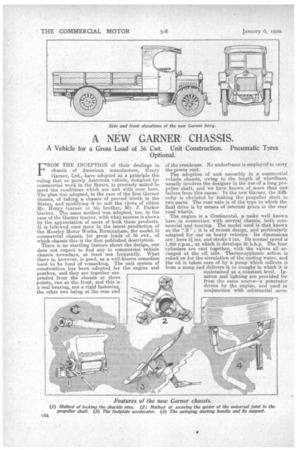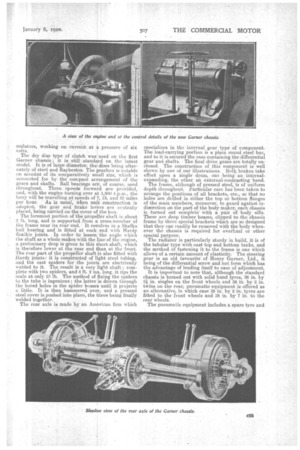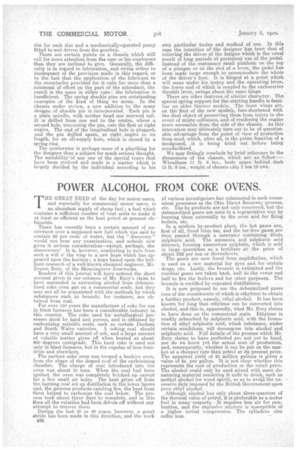A NEW GARNER CHASSIS.
Page 10

Page 11

Page 12

If you've noticed an error in this article please click here to report it so we can fix it.
A Vehicle for a Gross Load of 36 Cwt. Unit Construction. Pneumatic Tyres
Optional.
FROM THE INCEPTION of their dealings in chassis of American manufacture, Henry Garner, Ltd. have adopted as a principle the ruling that no purely American vehicle, designed for commercial work in the States, is precisely suited to meet the conditions which are met with over here. The plan. was adopted, in the case of the first Garner chassis, of taking a chassis of proved worth in the States, and modifying it to suit the views of either Mr. Henry Garner or his brother, Mr. 3. Parker Garner. The same method was adopted, too, in the case of the Garner tractor, with what success is shown by the appreciation of users of both these products. It is followed once more in the latest production of the Moseley Motor Works, Birmingham, the model 15 commercial chassis, for gross loads of 36 cwt., of which chassis this is the first published description.
There is no startling feature about the design one does not expect to find any in commercial vehicle chassis nowadays, at least not frequently. What there is, however, is good, as a well-known comedian used to be fond of remarking. The unit system of construction has been adopted for the engine and gearbox, and they are together suspended from the chassis at three points, one at the front, and this is a real bearing, not a rigid fastening, the other two being at the rear end of the crankcase. No underframe is employed to carry the power unit.
The adoption of unit assembly in a commercial vehicle chassis, owing to the length of wheelbase, usually 'involves the designer in the use of a long.propoller shaft, and we have known of more than one failure from this cause. In the new Garner, the difficulty is obviated by making the propeller shaft in twO parts. The rear axle is of the type in which the final drive is by means of internal gears in the rear road wheels.
The engine is a Continental, a make well known here in connection with several chassis, both commercial and touring. The model used is that known as the "N" ; it is of recent design, and particularly adapted for use on heavy vehicles. Its dimensions are : bore 31 ins, and stroke 5 ins. Its normal speed is 1,350 r.p.m., at which it develops 30 b.h.p. The. four cylinders are cast together, with the valves all arranged at the off side. Thermo-syphonie action is relied on for the circulation of the cooling water, and the oil is taken care of by a pump which collects it from a sump and delivers it to troughs in which it is maintained at a constant level. Ignition and lighting are provided for from the same source—a generator driven by he engine' and used in Conjunction with substantial • accit
mulators, working on current at a pressure of six volts. •
The dry disc type of clutch was used on the first Garner chassis; it is still standard on the latest Model. It is of large diameter, the discs being alternately of steel and Raybestos. The gearbox is notable on accoilnt of its comparatively small size, which is accounted for by the compact arrangement of the gears and shafts. Ball bearings are, of course, used throughout. Three, speeds forward are provided. and, with the engine turning over at 1,500 rp.m., the lorry will be travelling at speeds of 7, 13, and 22 miles per hour. As is usual, when unit construction is adopted, the gear and brake levers are centrally placed, being carried on the cover of the box.
The foremost portion of the propeller shaft is about
ft. long, and is supported from a cross-member of the frame near its rear end. It revolves in a Skefko ball bearing and is fitted at each end with Hardy flexible joints. In order to lessen. the angle which the shaft as a whole makes with the line of the engine, a. preliminary drop is given to this short shaft, which is therefore lower at the rear end than at the front. The rear part of the propeller shaft is also fitted with Hardy joints: it is constructed of light steel tubing, and the cast spiders for the joints are electrically welded to it. The result is a very light shaft ; complete with two spiders, and 4 ft. 2 ins, long, it tips the scale at only 10 lb. The method of fixing the spiders
i
to the tube s ingenious; the latter is driven through the bored holes in the spider bosses until it projects a little. It is then hammered over, and .a pressed steel cover is pushed into place, the diree being finally welded together.
The rear axle is made by an American firm which
specializes in the internal gear type of component. The load-carrying portion ik a, plain round steel bar, and to it is secured the ease containing the differential gear and shafts. The final drive gears are totally enclosed. The construction of this component is well shown by one of our illustrations. Both brakes take effeet upon a single drum, one being an internalexpanding, the other an external-contracting band.
The frame, although of pressed steel, is of uniform depth throughout. Particular care has been taken to arrange the positions of all brackets, etc., so that no holes are drilled in either the top or bottom flanges of the main members, moreover, to guard against indiscretion on the part of the body maker, each dliassis is. turned out complete with a pair of body sills. These are deep timber beam, clipped to the chassis frame by three special brackets' which are so designed that they can readily be removed with the body whenever the chassis is required. for overhaul or other special purpose.
The radiate"' is particularly sturdy in build, it is of the tubular type with cast top and bottom tanks, and the method. of fastening it to the frame is one which allows of a certain amount of elasticity. The steering gear is an old favourite of 'Henry Garner, Ltd., it being of the differential screw and nut farm which has the advantage of lending itself to ease of adjustment. It is important to note that, although the standard chassis is turned out with solid band tyres, 36 in. by 3i in. singles on the front wheels and 26 in. by 3 in. twins on the rear, pneumatic equipment is offered as an alternative, in which ca-se 35 in. by 5 in. tyres are fitted to the front wheels and 38 in. by 7 in. to the rear wheels.
The pneumatic equipment includes a spare tyre and rim for each Size and a mechanically-operated pump fitted to and driven from the gearbox.
There are certain points on a chassis which still call for More attention from the user or his employees than they are inclined to give: Generally, the difficulty is in regard to lubrication, and owing either to inadequacy of the provision made in this regard, or to the fact that the application of the lubricant to the receptacles provided for it Calls for more than a . minimum of effort on the part of the attendant, the result is the same in either case : the lubricationis insufficient. The spring shackle pins are outstanding examples of the kind of thing we mean. In the chassis under review, a new addition to the many designs of shackle pin i incorporated. Each pin is a plain spindle, with neither head or screwed tail. It is drilled from one end to the centre, where a second hole, traversing the pin, cuts the first at right angies. The end of the longitudinal 'hole is plugged, and the pin drilled again, • at right angles to its•length, for an oil-supply hole, which is closed by a
spring ring.
The accelerator is perhaps more of a plaything for the designer than a subject for much serious thought. The suita,bility----of any one of the special types that have been evolved and made is a matter which is largely decided by the individual according to his own particular tastes and method of Use. In this ease the intention of the designer has been that of relievingthe driver of the fatigue which is the usual result of long periods of persistent IL150 of the pedal. Instead of the customary small platform on the top of a plunger or at the end of a lever, the pedal has been made large enough to accommodate the whole of the driver's foot. It is .hinged at a point which will come under his instep and the operating lever, the lower end of which is coupled to the carburetter throttle lever, swings about the same hinge. There are other features of similar character. The special spring support for the starting handle is familiar on older Garner models. The front -wings are, on the first of the new 'models, fore-shortened With the dual object of preserving them from injury in the event of miner collisions,, and of rendering the engine more accessible from. the side of the chassis. As this innovation niay ultimately turn out to be of questionable advantage from the point of view of -protection from mud, which, after all, is the prime function of a inialguard, it is being tried out before being
standardized. •
We rnay fittingly conclude bY brief reference to the dimensions of the chassis, which are as fellow :Wheelbase 11 ft. 6 ins., body space behind dash 13 ft. 9 ins., weight, of chassis only 1 ton 1.0 cwt.


























